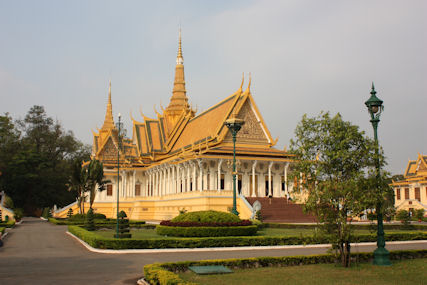A Simple Guide to Help Understand
Buddhist Art and Architecture
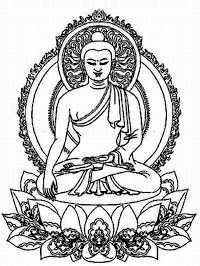
Jump Station:
[Stupa and Pagoda Distinguished]
[The Stupa]
[The Pagoda]
[ Buddhist Temple]
[Statues of Gautama Buddha]
[The Meaning of Buddha Hand Gestures]
[The Laughing Buddha]
When we arrived in Yangon, Myanmar, we first visited the Shwedagon (golden) Pagoda and, although it was much more elaborate and eliquant than I had imagined, it fit within my understanding of the term "pagoda". Then we flew to Bagan, Myanmar, which had been described as "The City of a Million Pagodas" and Lennie, our trip leader, started talking about the "Stupa", a term we had never heard before and which I tried despirately to understand. This is my attempt to describe the distinction. The best way for me to put it in common terms is to compare it to a comment I often made about wearing cowboy boots. "Every cowboy boot is a shoe but not all shoes are cowboy boots." Likewise, every stupa is a pagoda but not every pagoda is a stupa.
The stupa was originally built as a funerary monument covering a Buddha relic. Thus, you can think of it as a solid structure akin to a grave marker. It is not a building which can be entered like some pagodas. It evolved into the pagoda as Buddhism spread to other Asian countries. The pagoda has varied forms that also include bellshaped cones and pyramidal towers which are solid structures housing a relic. Today, in the Western context, there is no clear distinction between the stupa and the pagoda. But in general stupa is a term for a Buddhist structure in India or south-east Asia, while pagoda refers to a building in Asia which can be entered and which may have a secular in purpose.
The bottom line is: Every pagoda we saw was technically a stupa although some of them became elaborate and covered with gold.
A stupa (literally meaning "heap") is a mound-like structure containing Buddhist relics, once thought to be places of Buddhist worship, typically the remains of a Buddha or saint.
![]()
Stupa and Pagoda Distinguished
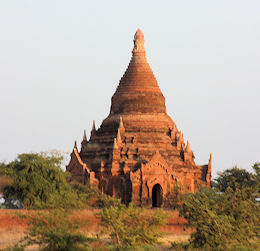
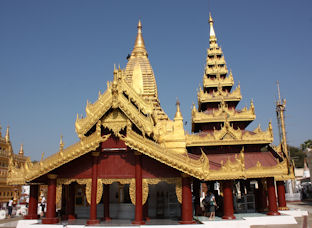
![]()
The Stupa
| The stupa was originally only a simple mound of mud or clay to cover supposed relics of the Buddha. After the death of the Buddha, his remains were cremated and the ashes divided and buried under eight stupas with two further stupas encasing the urn and the embers. Little is known about these early stupas, particularly since it has not been possible to identify the original ten monuments. Because of its contents the stupa has become a religious monument and over the years they became more elaborate with alcoves holding statues of the Buddha. | 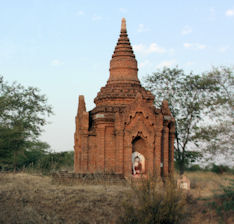 |
In the third century BC, after his conversion to Buddhism, the emperor Ashoka had the original stupas opened and the remains of Buddha distributed among the several thousand stupas he had built. Nevertheless, the stupas at the eight places associated with the life of the Buddha continued to be of particular importance. Accordingly, the importance of a stupa changed from being a funerary monument to being an object of veneration. As a consequence their appearance changed also. Stupas were built in Sri Lanka soon after King Devanampiyatissa converted to Buddhism. Later on Sri Lanka went on to build many stupas over the years, some being one of the tallest ancient structures in the world. Sri Lanka also boasts construction of stupas, which have used most advanced engineering techniques and knowledge, for example the use of 'lightning conductors' and 'special shelters which is the reason they have been standing undamaged for thousands of years.
| Eventually stupas evolved into large hemispherical mounds with features such as the gateway, the fence-like enclosure evolved from the vedic villages, the square platform with railings on top of the stupa, the parasol or canopy, and a circumambulatory around the stupa. It was not uncommon for these bell shaped stupas to be covered with gold.
| 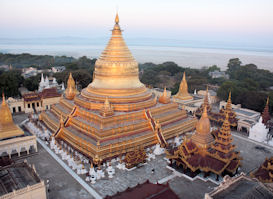 |
The stupa evolved into the pagoda as Buddhism spread to other Asian countries. The pagoda has varied forms that also include bellshaped and pyramidal cones. Today, in the Western context, there is no clear distinction between the stupa and the pagoda. But in general stupa is used for a Buddhist structure of India or south-east Asia, while pagoda refers to a building in east Asia which can be entered and which may be secular in purpose.
The Pagoda
| A pagoda is the general term in the English language for a tiered tower with multiple eaves common in China, Japan, Korea, Vietnam, and other parts of Asia. Some pagodas are used as Taoist houses of worship. Most pagodas were built to have a religious function, most commonly Buddhist, and were often located in or near temples. This term may refer to other religious structures in some countries. | 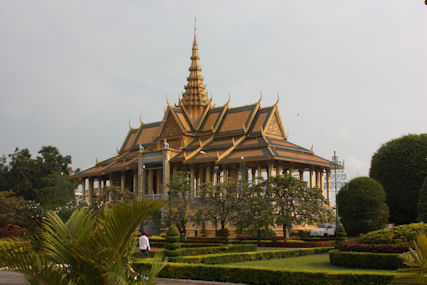 |
The origin of the pagoda can be traced to the Indian stupa (3rd century BCE). The stupa, a dome shaped monument, was used in India as a commemorative monument associated with storing sacred relics. The stupa emerged as a distinctive style of Indian architecture and was adopted in Southeast and East Asia, where it became prominent as a Buddhist monument used for enshrining sacred relics. In East Asia, the architecture of Chinese pavilions blended into pagoda architecture, eventually also spreading to Southeast Asia.
The pagoda's original purpose was to house relics and sacred writings. This purpose was popularized due to the efforts of Buddhist missionaries, pilgrims, rulers, and ordinary devotees to seek out, distribute, and extol Buddhist relics.
Pagodas attract lightning strikes because of their height. This tendency may have played a role in their perception as spiritually charged places. Many pagodas have a decorated finial at the top of the structure. The finial is designed in such a way as to have symbolic meaning within Buddhism; for example, it may include designs representing a lotus. The finial also functions as a lightning rod, and thus helps to both attract lightning and protect the pagoda from lightning damage. Early pagodas were constructed out of wood, but steadily progressed to sturdier materials, which helped protect against fires and rot.

Statues of Gautama Buddha
and What they Mean
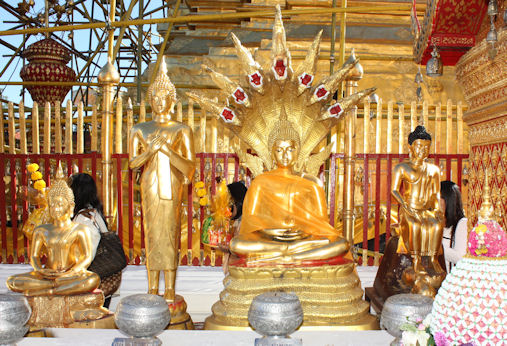
Just as stained glass windows in a Christian church are designed to tell a story to the illiterate masses, so do statues of Buddha pass a message to the observer. Unfortuanately those of us schooled in the history of Western Civilization are unfamiliar with these meanings which are known by every school boy and girl over the age of seven in a Buddhist country.
Most curiously, the Buddha is said to have had a protuberance on the top of his skull, usnisa. This is sometimes shown as a spire or spike, and sometimes only as a small bump. The small bump is generally a hair style or "bun". No one seems to know what the spire or spike represents although our guide said it is "like a halo or fire going into the sky."
The Buddha always has a serene expression or a faint smile. The Buddha is also always depicted with very long ear-lobes. This may be because in his earlier life as a prince he had always worn heavy earrings, but it has come to symbolize wisdom.
Regardless of pose, each Buddha statue serves essentially the same function--to inspire meditation and reflection upon the tenets of Buddhism. Different poses are designed to provide inspiration for different aspects of Buddhist teachings, to be sure, but they are all essentially meditative aids. Size is not really a key issue, though those statues who occupy a central place in temples do tend to be larger. However, there are often smaller representations of the Buddha dispersed across the temple grounds, to provide inspiration wherever a worshipper might choose to go.
Buddha may be depicted in one of four postures:
Sitting in the Lotus Position: The Buddha with his hands folded in his lap and his legs crossed, known as the lotus position, is the most common depiction. The lotus position represents the process of meditation, an important aspect of Buddhism. This is found almost everywhere Buddhism has taken root. The lotus position represents the process of meditation, an important aspect of Buddhism.
If seated, the Buddha is generally shown in one of two different positions:
- In the "heroic posture" (virasana), with the legs folded over each other, or
- In the "adamantine posture" (vajrasana), with the legs crossed so that the soles of both feet are turned up Burma Jan 15 a 041m
Walking
Reclining: Sometimes the Buddha will also be shown lying down in what is known as a reclining position. If his head is resting on his hand or is supported by his arm the Buddha is "just resting".
Buddha resting with students at his side
If, however, his head is on a pillow [see below] it generally representing the final passage into nirvana, which is the state of nothingness to which some sects of Buddhists aspire. This would mean you have passed on from the cycle of birth,life, death and rebirth with each life being better, or maybe worse, until you finally reached the highest level of merit and did not have to be reborn.
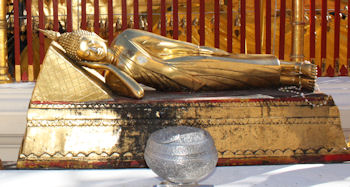
[Editor's note: Of course this has to be speculation and taken of faith because there is no way of knowing if the Buddha who reaches nervana isn't reborn. In Tibet the Dahli Lama, the supreme Buddhist, is always reborn. When he dies the monks go out on a search to find the child into whom the Dahli Lama was reborn.]
The most important aspect of the iconography of the Buddha is gestures made with the hands, known as mudra. These gestures have meanings which are known throughout the Buddhist world, and when combined with the postures described above, give a complete representation, usually associated with a particular incident in the life of the Buddha.
The six mudra associated with the Buddha are:
The hands are shown lying flat in the Buddha's lap, palms upward. This mudra is usually associated with a seated Buddha. It shows that the Buddha is disciplining his mind through mental concentration, a necessary step to achieving enlightenment.
The right hand hand rests on the right thigh with the fingers pointing downwards and touching or reaching down to the earth. The left hand rests in the dhyana mudra position in the Buddha's lap. This mudra is frequently called "Calling the earth to witness," or by its more literal meaning, "Buddha subduing Mara", the demon who tempted the Buddha by trying to seduce him with the vision of beautiful women. The gesture thus symbolises the Buddha's renunciation of worldly desire, and since this is the central moral precept of Buddhism this is by far the most commonly depicted mudra.
The right arm is shown pendent (extended downwards), with the open palm turned to the front and the fingers extended. This mudra is usually associated with a standing Buddha. This position can signify either that the Buddha is granting or receiving charitable offerings.
The arm and hand are positioned in the same manner as in the "Absence of Fear", except that the thumb and forefinger are brought together. The gesture can be made with either the right or left hand (usually the right), but not both. This mudra signifies an appeal to reason, or the giving of instruction. Since the Buddha is appealing to reason, the gesture is often interpreted as an appeal for peace.
The hands are held in front of the chest, with both hands in the Charity position, with the fingers of the left hand resting in the palm of the right hand. This is a less common mudra since it refers to a particular episode in the Buddha's life: his first sermon, when he "set the wheel(of his life's work)in motion."
Another frequently depicted postures include the Buddha with a raised hand or a hand touching the earth. If the hand is raised, it signifies a warding off of things that would cause fear. If the hand is touching the earth, it conveys the solidness of the ground in a metaphor for the stability of true Buddhist faith.
Budai is a Chinese folklore deity. His name means "Cloth Sack," and comes from the bag that he carries. He is almost always shown smiling or laughing hence his nickname in Chinese, the Laughing Buddha. In English speaking countries, he is popularly known also as the Fat Buddha.
Budai is often depicted as having the appearance of an amply proportioned bald man wearing a robe and wearing or otherwise carrying prayer beads. He carries his few possessions in a cloth sack, being poor but content.
His figure appears throughout Chinese culture as a representation of contentment. His image graces many temples, restaurants, amulets, and businesses
Among Westerners, new to Buddhism, Budai is often confused with the historical Buddha, Siddhartha Gautama. However, the two are visually very distinct. Gautama is commonly depicted as being tall and slender in appearance (although since no images of him from his lifetime exist, this depiction of him is unverifiable and possibly idealized); Budai is short and overweight.
According to Chinese tradition, Budai was an eccentric Chinese Zen (Chán) monk who lived during the Later Liang Dynasty (907–923 CE) of China. He was a native of Fenghua, and his Buddhist name was Qieci (literally "Promise this"). He was considered a man of good and loving character.
Although primarily a folkloric figure, he has been incorporated into a number of Buddhist and Taoist folklore tradition.
The Meaning of Hand Gestures
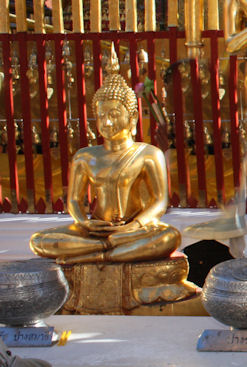
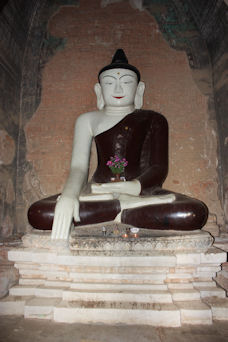
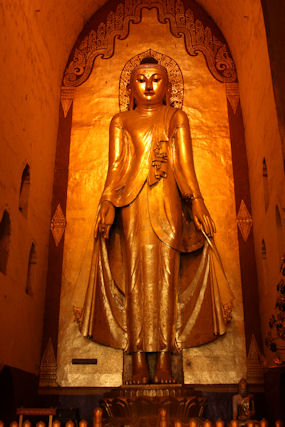 One or both arms are shown bent at the elbow and the wrist, with the palm facing outwards and the fingers pointing upwards. It shows the Buddha either displaying fearlessness in the face of adversity, or enjoining others to do so. Right hand raised is also called "calming animals"; both hands raised is also called "forbidding the relatives". This mudra are usually associated with a standing Buddha, but seated representations are not uncommon.
One or both arms are shown bent at the elbow and the wrist, with the palm facing outwards and the fingers pointing upwards. It shows the Buddha either displaying fearlessness in the face of adversity, or enjoining others to do so. Right hand raised is also called "calming animals"; both hands raised is also called "forbidding the relatives". This mudra are usually associated with a standing Buddha, but seated representations are not uncommon. 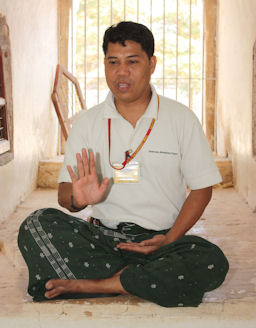
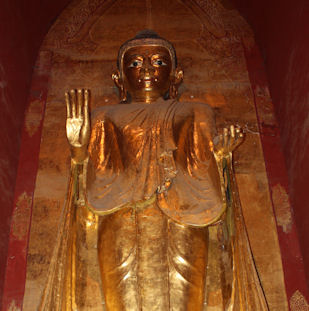
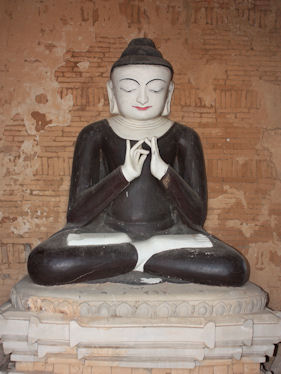 I'm still searching for the right photo
I'm still searching for the right photo
I must have one someplace.
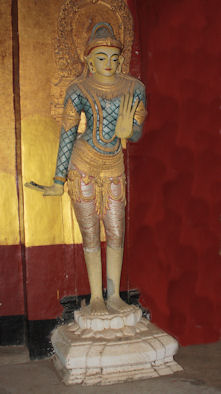

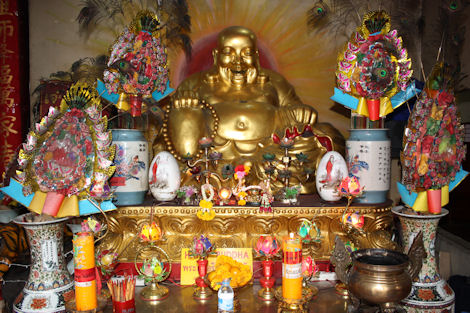
The "Laughing Buddha" or "Happy Buddha"
in Chinatown, Bangkok.
(Editor's note, May 3, 2010: This page is now being construction so come back again.
If you have any insights - constructive comments - you wish to share please do so.)
